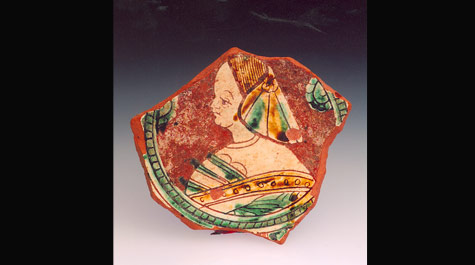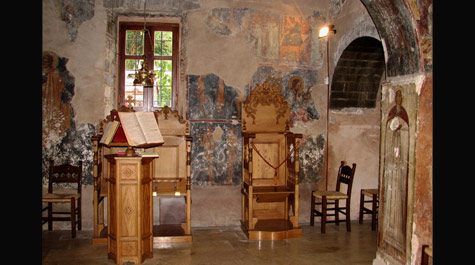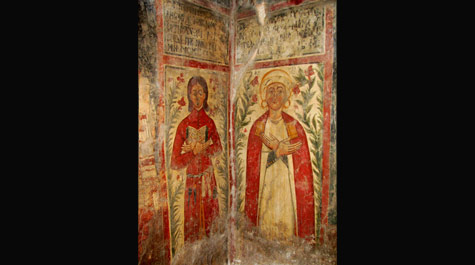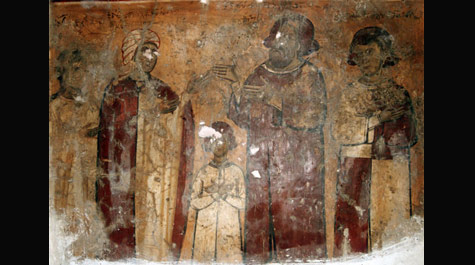Stancioiu nets grant to study portraiture in Crete
William & Mary Assistant Art History Professor Cristina Stancioiu will spend much of this summer in Crete and Rhodes, thanks in part to a Franklin Research Grant from the American Philosophical Society.
“They fund library, archive and field work, and I meet a little bit of all of that,” Stancioiu explained. “I think it appealed to them that I would take the grant abroad, away from my home institution.”
Stancioiu is using the grant to further her first book, centered on portraiture in the Eastern Mediterranean from the end of the 13th century through the 17th century.
“Conducting research is a time-consuming and costly enterprise making external funding sources a necessary component to anyone's research agenda,” Art and Art History Chair Elizabeth Mead said. “However, the American Philosophical Society’s Franklin Research Grant, while funding research and travel, is also recognizing the significance and quality of Professor Stancioiu's work. Quite a remarkable acknowledgment for this stage of her career. The department is thrilled for her.”
Stancioiu finds the portraits in remote Orthodox churches in the Grecian countryside, in areas that were originally part of the Byzantine Empire but had shifted to Venetian or European rule by the time the portraits were created.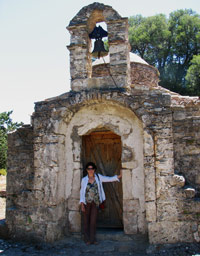
“I go and literally travel from church to church,” she said. She hikes across fields, down through ravines, to the tops of mountains to find the tiny and all-but-forgotten churches.
“The people in the villages are happy to hear that I’m interested in the old church, and they always ask me, ‘How do you know about that?’
“And I say, ‘From books.’
“And they are amazed there are books about their church.”
Actually, there’s only one book. A 1907 collection published by an Italian scholar who walked the countryside, recording every church and making watercolors of the frescoes, is to date the most exhaustive catalog. For illustration, there are about 800 medieval churches just on Crete alone.
“These are small churches. They are not your gothic cathedrals,” Stancioiu said. “It’s impossible to maintain and restore all of them, so I think there is an immediate need to at least photograph what is still there.”
Even in the five years between visits, she witnessed degradation in a fresco of a family portrait she first photographed in 2007.
But more than simply cataloging the portraits, Stancioiu is interested in what they tell scholars about the people who created them.
At the time, as an aftermath of the Crusades, the Eastern Mediterranean was very diverse, with traditional Byzantine and Greek culture (and its Eastern Orthodox Church) meeting transient Europeans – Italians, French and Germans – who came through the area and were generally Catholic, or from the Middle East, either Christian or Muslims.
“They are all interacting,” she continued. “And artistically, this is a very interesting period because you have artwork that reflects all of these cultures. So these used to be Byzantine Greek territories, where Greek is spoken, people are Orthodox, but they are ruled by either Venice or other European powers. So they have to negotiate a new way of expressing their identities.”
Ironically, the act of portraiture itself came with the shift in power. Portraiture was not an everyday artistic tradition native to Byzantium, aside from portraits of the emperor or portraits of the saints – icons.
Stancioiu is instead looking at portraits of secular people, once the local nobility, who were pushed into the countryside and stripped of their lands. “Interestingly enough, they take portraiture, which is a novel genre, an imported genre, and they use it very subversively to create a link to their own Byzantine past.”
Stancioiu noted that in family portraits, men are dressed trendily according to their profession, as one would expect. But women are portrayed in gowns that were in style during the height of the Byzantine Empire, when the islands were part of Byzantium.
“Dress is the best way to speak of identity and to create, literally, the image you want remembered,” she said. “So they wear this outdated style of dress that speaks of their past, rather than their present.
“And this was the interesting surprise I had with this research, that it took this gender twist, where it is in the images of women that I see these very strong political claims.”
The churches’ remoteness allowed the former nobles to be bold in the portraits. “No lord would ever step foot in those churches; they are exclusively for the local community, so it’s a safe place to make that kind of statement.”
They are still safe from the lords today, though the monuments they house are technically under the aegis of the Department of Antiquities.
“The church does what it can. The government does what it can, and the people in the villages do what they can,” Stancioiu explained. “So they try to fix the roof and not let water leak or they keep the door shut, things like that.
“But I’m always touched by how much they care about these monuments. There is always a candle lit. Even if the church is no longer in use, they still will light candles at the icons. Things like that show me they care, and explains why they are so welcoming when they see me coming and being interested in their monuments.”
She estimates that of the 800 or so churches on Crete, probably 70 feature portraits. She’ll try to see as many of them as she can in June and July, also conducting research in libraries in Athens, Nicosia and Venice. She hopes to have the manuscript written by August next year.
Naturally, her research informs her classes. “I teach a seminar on cultural interaction in the Mediterranean where we look at a lot of these places I travel and research,” she said. “It’s always exciting to show the students what I do and see what they think, because they have that fresh eye and ask really interesting questions that make me think about new things.”
 Skip to main content
Skip to main content

